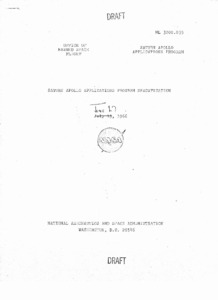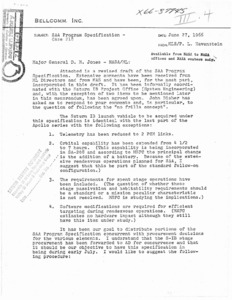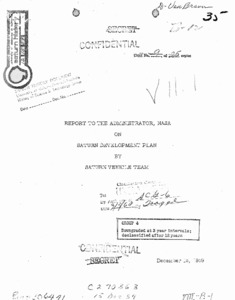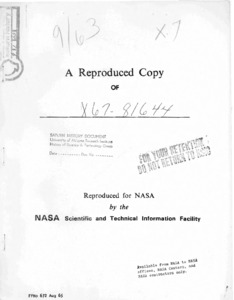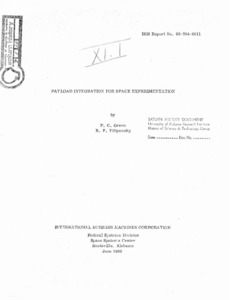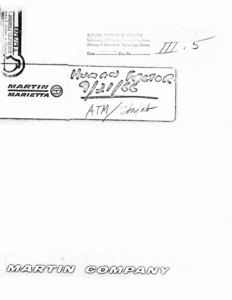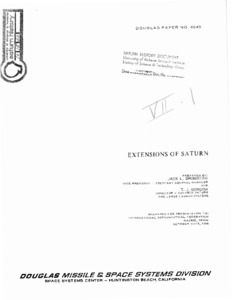
Browse Items (9 total)
Sort by:
-
"Statistical model for Saturn electrical support equipment mission availability."
This report presents the logic leading to a mathematical expression for mission availability. Mission availability is treated as the probability that the cumulative downtime occurring during a mission of given length will be less than the time constraint. This is opposed to more general approaches such as steady state or instantaneous availability or operating time versus real time. We intend to present a practical and usable mathematical model by deduction and demonstration. The development is based on exponentially distributed downtimes. Experience shows that certain systems follow exponential downtime distributions except near zero. This error is often so small that it may be neglected. A future report will present a downtime distribution which will account for this small error. -
"Saturn Apollo applications program specification."
This first issue contains only some general provisions for the program and its requirements for the Saturn 1B launch vehicle. -
"SAA program specification - case 218."
Memo sent to Major General D. M. Jones - NASA/ML. -
"Report to the administrator, NASA on the Saturn development plan."
In anticipation of this transfer, the NASA and Department of Defense have established, an interim working agreement that provides for immediate assumption by NASA of responsibilities fortechnical management of the Saturn vehicle development. -
"Program scheduling manual."
Manual centered around teaching program schedueling. -
"Payload integration for space experimentation."
Space experimentation requires an increasingly complex planning and systems engineering effort to meet the demand for highest precision and reliability of all measurements and observations. A companion paper discusses the interfaces between the scientific/technical areas of space experimentation and the instruments, subsystems and support systems within the spacecraft. This paper deals with the organization and the procedures which are needed to perform the difficult payload integration process for space experimentation. In the course of this process it is necessary to define the experiments completely, to describe all instruments in terms of engineering specifications, to investigate the commonality of equipment, to group the experiments into mission compatible payloads, to specify acceptable loads on all subsystems and astronauts (when present) and to plan for all contingencies during the flight. -
"Human Factor: ATM /Skylab."
Statement of work: Man/Machine activities -ATM; ATM problem areas; EVA commuting problem; Other EVA considerations; Analysis of crew considerations Mission 211/212; Mission objectives Crew Considerations; Mission Fight Profile & Operations Crew Considerations; Experiment operations crew considerations; EVA equipment requirements; Crew considerations carrier recommendations; Conclusions and recommendations crew considerations; Crew operations requirements preliminary 10 August 1996; ATM stabilization and control; ATM Carrier habitability and profile; Other ATM man/machine considerations.; Original is a poor photocopy.; Document has no page numbering. -
"Extensions of Saturn."
This paper discusses the possible applications of Saturn vehicles to future space exploration. Potential missions utilizing Apollo derived hardware are examined. Research, development, and operations in earth orbit as well as lunar exploration, unmanned and manned interplanetary exploration are reviewed. These hypothetical missions are discussed in the context of the present and potential capability of three configurations of the Saturn vehicle; an uprated Saturn I, a three-stage Saturn V and a four-stage Saturn V. NOTE: Work presented herein was conducted by the Douglas Missiles and Space Systems Division under company-sponsored research and development funds. Therefore, the concepts and objectives described within this paper reflect the opinions of the authors and do not necessarily constitute endorsement by NASA, the Air Force, or any other U.S. Government organization. The nominal performance numbers presented are typical of the current configurations and possible future vehicle configurations. -
"Preliminary skeletal operations plan for Apollo :" a systems engineering support document.
The Preliminary Skeletal Operations Plan is a statement of the operational concept for Apollo. This draft contains a description of the conduct of the Apollo LOR landing mission and a mission profile. It provides the basis for more detailed mission planning, for generating functional criteria for equipment design, and for measuring the adequacy of the current Apollo hardware for satisfying operational needs.

